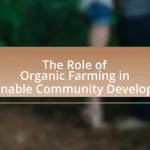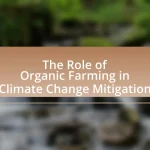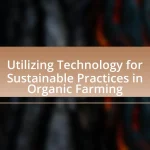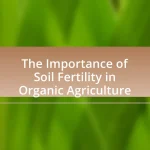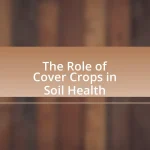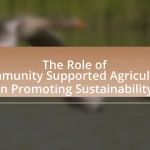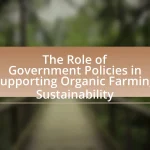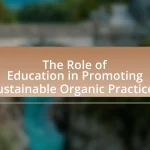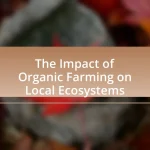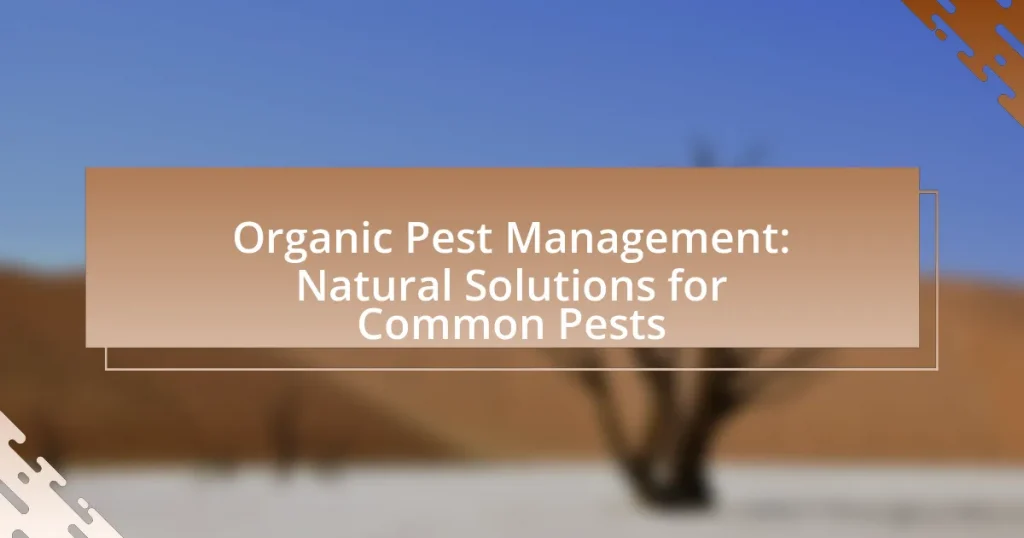Organic Pest Management (OPM) is an environmentally friendly approach to controlling pests through natural methods and substances, emphasizing biological control agents, cultural practices, and organic-approved pesticides. This article explores the differences between OPM and conventional pest management, highlighting key principles such as prevention, monitoring, and control. It discusses the importance of OPM for sustainability, its impact on human health, and the environmental benefits it provides, including enhanced biodiversity and improved soil health. Additionally, the article outlines practical strategies for implementing OPM effectively, the challenges faced, and resources available for support, ultimately demonstrating how OPM can successfully manage various pests while promoting ecological balance.
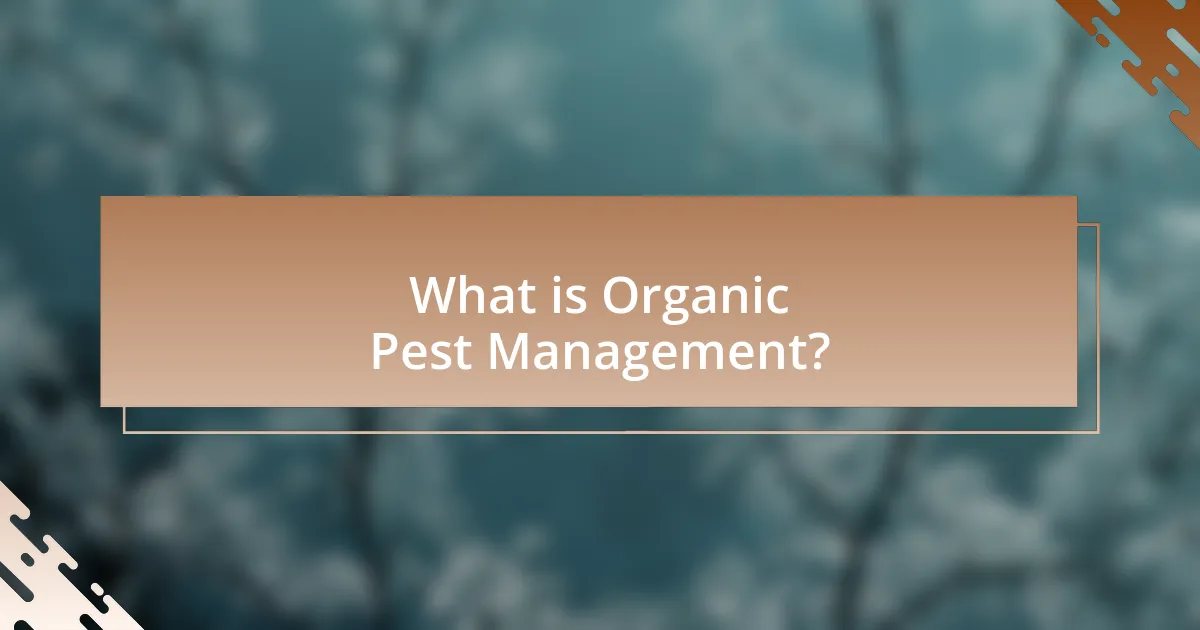
What is Organic Pest Management?
Organic Pest Management is an environmentally friendly approach to controlling pests using natural methods and substances. This method emphasizes the use of biological control agents, cultural practices, and organic-approved pesticides to minimize harm to non-target organisms and the ecosystem. Research indicates that organic pest management can effectively reduce pest populations while promoting biodiversity and soil health, as seen in studies conducted by the Rodale Institute, which found that organic farming practices can lead to higher levels of beneficial insects and improved soil quality compared to conventional methods.
How does Organic Pest Management differ from conventional methods?
Organic Pest Management (OPM) differs from conventional methods primarily in its reliance on natural processes and materials rather than synthetic chemicals. OPM employs biological control agents, such as beneficial insects and microbial pesticides, to manage pest populations, while conventional methods often utilize chemical pesticides that can have harmful environmental and health effects. Research indicates that OPM practices can enhance biodiversity and soil health, as they promote ecological balance, whereas conventional methods may lead to pesticide resistance and ecosystem disruption. For instance, a study published in the journal “Agriculture, Ecosystems & Environment” found that organic farming systems support higher levels of biodiversity compared to conventional systems, demonstrating the ecological benefits of OPM.
What are the key principles of Organic Pest Management?
The key principles of Organic Pest Management include prevention, monitoring, and control using natural methods. Prevention focuses on creating a healthy ecosystem that discourages pest infestations, such as crop rotation and the use of resistant plant varieties. Monitoring involves regularly checking for pest populations and damage to make informed decisions. Control methods prioritize natural solutions, such as beneficial insects, organic pesticides, and cultural practices, rather than synthetic chemicals. These principles are supported by research indicating that organic practices can effectively manage pests while promoting environmental health and biodiversity.
Why is Organic Pest Management important for sustainability?
Organic Pest Management is important for sustainability because it reduces reliance on synthetic pesticides, which can harm ecosystems and human health. By utilizing natural pest control methods, such as beneficial insects and organic treatments, organic pest management promotes biodiversity and soil health. Research indicates that organic farming practices can enhance soil fertility and reduce pollution, contributing to long-term agricultural sustainability. For instance, a study published in the journal “Agriculture, Ecosystems & Environment” found that organic farming systems can increase soil organic matter and improve water retention, which are critical for sustainable agriculture.
What types of pests can be managed organically?
Organic pest management can effectively address various types of pests, including insects, weeds, and diseases. Common insect pests managed organically include aphids, spider mites, and whiteflies, which can be controlled using natural predators like ladybugs or through the application of insecticidal soaps. Weeds such as dandelions and crabgrass can be managed through mulching and hand-pulling, while diseases like powdery mildew can be treated with organic fungicides or by promoting air circulation around plants. Research indicates that organic methods can reduce pest populations while maintaining ecological balance, supporting the effectiveness of these strategies in sustainable agriculture.
How do common garden pests affect plants?
Common garden pests negatively affect plants by causing physical damage, transmitting diseases, and reducing overall plant health. For instance, aphids and spider mites feed on plant sap, leading to stunted growth and yellowing leaves. Additionally, pests like whiteflies can transmit viral infections, further compromising plant vitality. Research indicates that infestations can lead to yield losses of up to 50% in some crops, highlighting the significant impact of these pests on agricultural productivity.
What are the signs of pest infestation in organic farming?
Signs of pest infestation in organic farming include visible damage to plants, such as chewed leaves, holes, or wilting, as well as the presence of pests themselves, like aphids or caterpillars. Additionally, farmers may observe unusual droppings, webbing, or a decline in plant health, which can indicate pest activity. Monitoring these signs is crucial, as studies show that early detection can significantly reduce crop loss and improve management strategies.
What natural solutions are available for pest control?
Natural solutions for pest control include the use of beneficial insects, essential oils, diatomaceous earth, and homemade sprays. Beneficial insects, such as ladybugs and lacewings, prey on harmful pests, effectively reducing their populations. Essential oils like neem oil and peppermint oil repel pests due to their strong scents and properties. Diatomaceous earth, a natural powder made from fossilized algae, disrupts the exoskeletons of insects, leading to dehydration and death. Homemade sprays, often made from soap and water or vinegar, can deter pests when applied directly to affected areas. These methods are environmentally friendly and have been shown to be effective in managing pest populations without the use of synthetic chemicals.
How do beneficial insects contribute to pest management?
Beneficial insects contribute to pest management by acting as natural predators, parasitoids, or competitors to harmful pests. For example, ladybugs consume aphids, while parasitic wasps lay eggs in pest species, ultimately controlling their populations. Research indicates that the presence of beneficial insects can reduce pest populations by up to 50%, enhancing crop health and yield. This natural form of pest control minimizes the need for chemical pesticides, promoting a healthier ecosystem and sustainable agricultural practices.
What role do natural repellents play in Organic Pest Management?
Natural repellents play a crucial role in Organic Pest Management by providing an eco-friendly alternative to synthetic pesticides. These repellents, derived from natural sources such as plants and essential oils, deter pests without harming beneficial insects or the environment. Research indicates that natural repellents can effectively reduce pest populations; for example, studies have shown that neem oil and citronella oil can repel mosquitoes and other harmful insects. By integrating natural repellents into pest management strategies, organic farmers can maintain crop health while adhering to organic farming principles.
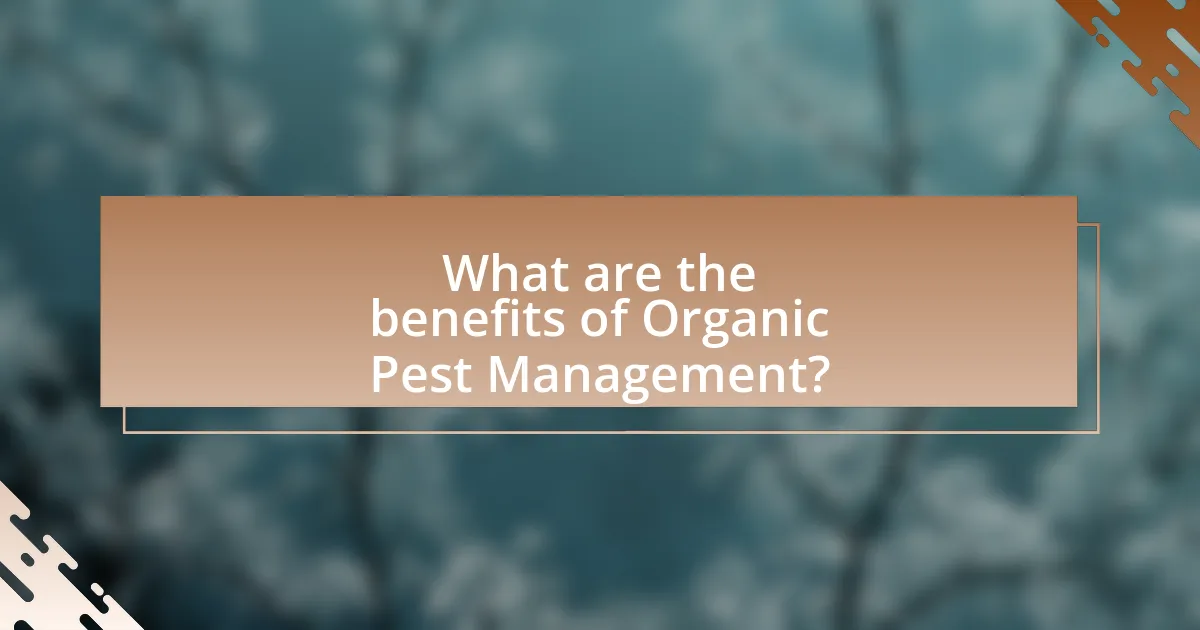
What are the benefits of Organic Pest Management?
Organic Pest Management offers several benefits, including reduced chemical exposure, enhanced biodiversity, and improved soil health. By utilizing natural pest control methods, such as beneficial insects and organic pesticides, farmers and gardeners minimize the risks associated with synthetic chemicals, which can harm non-target species and contaminate water sources. Studies indicate that organic practices can increase the presence of beneficial organisms, leading to a more balanced ecosystem. Additionally, organic pest management contributes to healthier soil by promoting microbial activity and nutrient cycling, which are essential for sustainable agriculture.
How does Organic Pest Management impact human health?
Organic Pest Management positively impacts human health by reducing exposure to harmful synthetic pesticides. Studies indicate that organic farming practices, which prioritize natural pest control methods, lead to lower pesticide residues on food products. For instance, research published in the Journal of Agricultural and Food Chemistry found that organic produce contains significantly fewer pesticide residues compared to conventionally grown produce, thereby minimizing potential health risks associated with chemical exposure, such as endocrine disruption and neurotoxicity. Additionally, organic pest management promotes biodiversity, which can enhance ecosystem services that contribute to overall human well-being.
What are the health risks associated with chemical pesticides?
Chemical pesticides pose several health risks, including acute poisoning, chronic health effects, and potential carcinogenicity. Acute exposure can lead to symptoms such as headaches, dizziness, nausea, and respiratory issues, while long-term exposure has been linked to neurological disorders, reproductive harm, and endocrine disruption. For instance, studies have shown that certain pesticides, like organophosphates, can impair cognitive function and are associated with developmental delays in children. Additionally, the International Agency for Research on Cancer has classified some pesticides as probable human carcinogens, highlighting the serious risks they pose to human health.
How can Organic Pest Management improve food safety?
Organic Pest Management improves food safety by reducing the reliance on synthetic pesticides, which can leave harmful residues on food products. By utilizing natural pest control methods, such as beneficial insects and organic-approved substances, the risk of chemical contamination is minimized. Studies indicate that organic farming practices can lead to lower pesticide residues in food, enhancing consumer safety. For instance, research published in the Journal of Agricultural and Food Chemistry found that organic produce had significantly lower levels of pesticide residues compared to conventionally grown produce, thereby supporting the assertion that Organic Pest Management contributes positively to food safety.
What environmental benefits does Organic Pest Management provide?
Organic Pest Management provides significant environmental benefits by reducing chemical pesticide use, which minimizes soil and water contamination. This method promotes biodiversity by protecting beneficial insects and other wildlife, thereby maintaining ecosystem balance. Studies indicate that organic practices can enhance soil health, as they often involve crop rotation and the use of organic fertilizers, which improve soil structure and fertility. Additionally, organic pest management contributes to sustainable agriculture by fostering resilience against pests and diseases without relying on synthetic chemicals, ultimately leading to healthier agricultural systems.
How does Organic Pest Management promote biodiversity?
Organic Pest Management promotes biodiversity by utilizing natural pest control methods that enhance ecosystem health. This approach reduces reliance on synthetic pesticides, which can harm non-target species and disrupt ecological balance. By encouraging beneficial insects, such as pollinators and natural predators, organic practices foster a diverse range of species within agricultural systems. Research indicates that organic farms typically host higher levels of biodiversity compared to conventional farms, with studies showing that organic practices can increase species richness by up to 30%. This biodiversity contributes to improved soil health, pest resilience, and overall ecosystem stability.
What are the long-term effects of Organic Pest Management on soil health?
The long-term effects of Organic Pest Management on soil health include improved soil structure, enhanced microbial diversity, and increased nutrient availability. Organic Pest Management practices, such as crop rotation and the use of organic amendments, contribute to the development of a healthier soil ecosystem. Research indicates that these practices can lead to a significant increase in beneficial microorganisms, which play a crucial role in nutrient cycling and soil fertility. For instance, a study published in the journal “Agriculture, Ecosystems & Environment” found that organic farming systems can enhance soil organic matter content by 20-30% over time, thereby improving soil health and resilience.
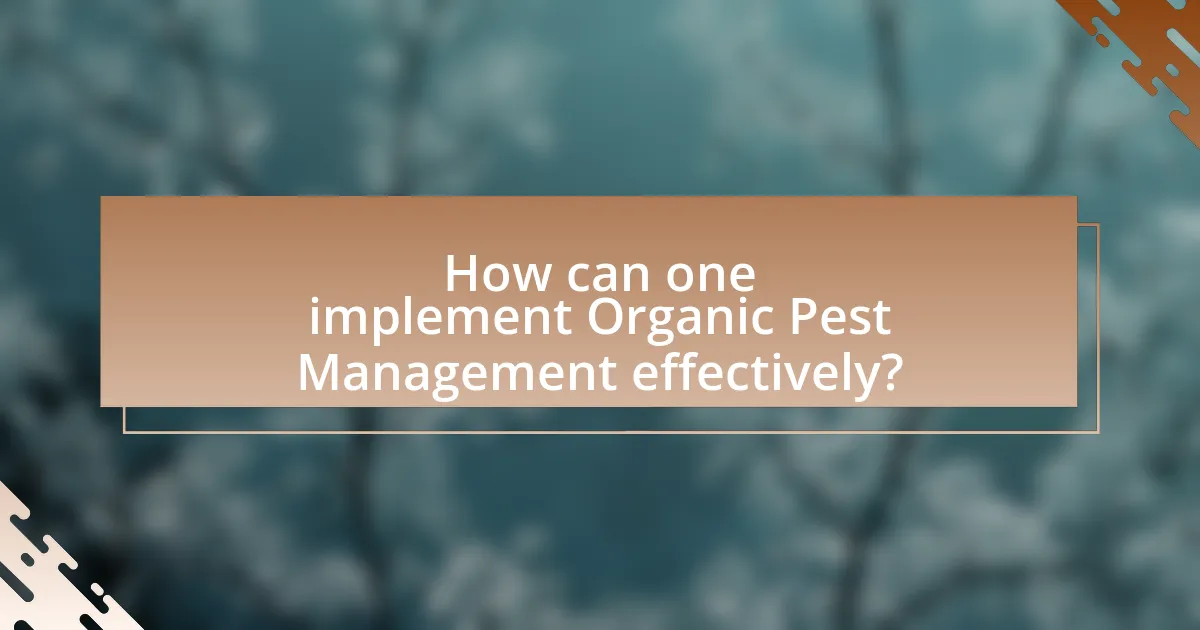
How can one implement Organic Pest Management effectively?
To implement Organic Pest Management effectively, one should utilize a combination of cultural, biological, and mechanical control methods. Cultural practices include crop rotation, selecting pest-resistant plant varieties, and maintaining healthy soil to promote plant vigor, which can reduce pest susceptibility. Biological control involves introducing natural predators or parasites of pests, such as ladybugs for aphids, which can help maintain pest populations at manageable levels. Mechanical methods include physical barriers like row covers and traps to prevent pest access and capture them. Research indicates that integrated approaches combining these methods can lead to a significant reduction in pest populations while minimizing chemical inputs, as demonstrated in studies published by the University of California Agriculture and Natural Resources, which highlight the effectiveness of these strategies in organic farming systems.
What are the best practices for starting Organic Pest Management?
The best practices for starting Organic Pest Management include understanding pest life cycles, implementing cultural controls, and utilizing biological controls. Understanding pest life cycles allows for targeted interventions at critical stages, reducing pest populations effectively. Implementing cultural controls, such as crop rotation and selecting pest-resistant plant varieties, minimizes pest establishment and proliferation. Utilizing biological controls, like introducing beneficial insects or microbial pesticides, leverages natural predators to manage pest populations sustainably. These practices are supported by research indicating that integrated approaches enhance pest management efficacy while maintaining ecological balance.
How can crop rotation enhance pest management strategies?
Crop rotation enhances pest management strategies by disrupting the life cycles of pests and diseases that thrive on specific crops. By alternating different crops in a given area, farmers can reduce the prevalence of pests that are adapted to particular plants, thereby minimizing their populations. Research indicates that crop rotation can lead to a significant decrease in pest populations; for example, a study published in the journal “Agriculture, Ecosystems & Environment” found that rotating crops reduced pest infestations by up to 50% in certain cases. This method not only helps in managing pests but also improves soil health and biodiversity, further supporting sustainable agricultural practices.
What monitoring techniques are essential for effective pest management?
Essential monitoring techniques for effective pest management include visual inspections, trap monitoring, and the use of pest forecasting models. Visual inspections allow for the early detection of pest populations and damage, enabling timely interventions. Trap monitoring, such as sticky traps or pheromone traps, provides quantitative data on pest presence and population dynamics, which is crucial for making informed management decisions. Pest forecasting models utilize environmental data and pest life cycle information to predict pest outbreaks, allowing for proactive management strategies. These techniques collectively enhance the ability to manage pests effectively in organic pest management systems.
What challenges might one face in Organic Pest Management?
One challenge faced in Organic Pest Management is the limited availability of effective organic pesticides. Organic pesticides often have lower efficacy compared to synthetic alternatives, which can lead to inadequate pest control. For instance, studies have shown that organic pest control methods may require more frequent applications and can be less effective against certain pest populations, resulting in potential crop damage and reduced yields. Additionally, the reliance on natural predators and biological controls can be unpredictable, as these methods depend on environmental conditions and the presence of beneficial organisms.
How can one overcome common obstacles in Organic Pest Management?
To overcome common obstacles in Organic Pest Management, one can implement integrated pest management strategies that combine biological control, cultural practices, and mechanical methods. These strategies effectively reduce pest populations while minimizing reliance on synthetic chemicals. For instance, introducing beneficial insects like ladybugs can naturally control aphid populations, while crop rotation can disrupt pest life cycles and reduce infestations. Research indicates that farms employing integrated pest management techniques can see a 30-50% reduction in pest-related crop damage, demonstrating the effectiveness of these methods in organic systems.
What resources are available for support in Organic Pest Management?
Resources available for support in Organic Pest Management include university extension services, organic farming associations, and government agricultural departments. University extension services provide research-based information and guidance on organic pest management practices, often offering workshops and publications. Organic farming associations, such as the Organic Trade Association, offer resources, networking opportunities, and advocacy for organic practices. Additionally, government agricultural departments, like the USDA, provide guidelines and support for organic certification and pest management strategies. These resources are essential for farmers seeking effective and sustainable pest management solutions.
What practical tips can enhance Organic Pest Management success?
Implementing crop rotation is a practical tip that can enhance Organic Pest Management success. Crop rotation disrupts pest life cycles by alternating the types of crops grown in a specific area, which reduces the likelihood of pest infestations. Research indicates that rotating crops can decrease pest populations by up to 50%, as pests often rely on specific host plants for survival. Additionally, incorporating beneficial insects, such as ladybugs and lacewings, can naturally control pest populations by preying on harmful insects. Studies show that fields with higher populations of beneficial insects experience significantly lower pest damage, reinforcing the effectiveness of this strategy.

